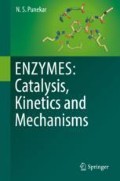Abstract
Biochemists enjoy the freedom to purify and study enzymes in isolation, saturate an enzyme with its substrate, trap/remove the products, and also provide optimal pH, ionic strength, etc. On the other hand, cell extracts are by their very nature “dirty enzymes”; intact cells and organisms are “dirtier” still. The cell by design is greatly constrained to provide a consensus medium to simultaneously support hundreds of diverse enzyme-catalyzed reactions. Only some of these enzymes may be operating under optimal conditions at any time. The context for an enzyme to function in vivo is very different from the well-defined conditions deliberately set up for its study in vitro. And classical biochemistry is founded on several assumptions valid in dilute aqueous solutions. These assumptions are often extended without question to the cellular milieu. But the cell interior is far away from being an ideal solution. The key features that differentiate the state of affairs in vivo from that in vitro are cataloged below.
(The biochemist’s word) may not be the last in the description of life, but without his help the last word will never be said.
Sir Gowland Hopkins
Access this chapter
Tax calculation will be finalised at checkout
Purchases are for personal use only
References
Albe KR, Butler MH, Wright BE (1990) Cellular concentrations of enzymes and their substrates. J Theor Biol 143:163–195
Banani SF, Lee HO, Hyman AA, Rosen MK (2017) Biomolecular condensates: organizers of cellular biochemistry. Nat Rev Molec Cell Biol 18:285–298
Benner SA (1989) Enzyme kinetics and molecular evolution. Chem Rev 89:789–806
Bennett BD, Kimball EH, Gao M, Osterhout R, Van Dien SJ, Rabinowitz JD (2009) Absolute metabolite concentrations and implied enzyme active site occupancy in Escherichia coli. Nat Chem Biol 5:593–599
Burbaum JJ, Raines RT, Albery WJ, Knowles JR (1989) Evolutionary optimization of the catalytic effectiveness of an enzyme. Biochemistry 28:9293–9305
Castellana M, Wilson MZ, Xu Y, Joshi P, Cristea IM, Rabinowitz JD, Gitai Z, Wingreen NS (2014) Enzyme clustering accelerates processing of intermediates through metabolic channeling. Nat Biotechnol 32:1011–1018
Dang L, White DW, Gross S, Bennett BD, Bittinger MA, Driggers EM, Fantin VR, Jang HG, Jin S, Keenan MC, Marks KM, Prins RM, Ward PS, Yen KE, Liau LM, Rabinowitz JD, Cantley LC, Thompson CB, Vander Heiden MG, Su SM (2009) Cancer-associated IDH1 mutations produce 2-hydroxyglutarate. Nature 462:739–744
Dave K, Punekar NS (2015) Expression of lactate dehydrogenase in Aspergillus niger for L-lactic acid production. PLoS One 10(12):e0145459
Dobzhansky T (1973) Nothing in biology makes sense except in the light of evolution. Am Biol Teach 35:125–129
Ellis RJ (2001) Macromolecular crowding: obvious but underappreciated. Trends Biochem Sci 26:597–604
Fischbach MA, Walsh CT (2006) Assembly-line enzymology for polyketide and nonribosomal peptide antibiotics: logic, machinery, and mechanisms. Chem Rev 106:3468–3496
Halling PJ (1989) Do the laws of chemistry apply to living cells? Trends Biochem Sci 14:313–353
Hardt SL (1979) Rates of diffusion controlled reactions in one, two and three dimensions. Biophys Chem 10:239–243
Hasinoff BB (1984) Kinetics of carbonic anhydrase catalysis in solvents of increased viscosity: a partially diffusion controlled reaction. Arch Biochem Biophys 233:676–681
Knowles JR, Albery WJ (1977) Perfection in enzyme catalysis: the energetics of trisoephosphate isomerase. Acc Chem Res 10:105–111
Kornberg A (2000) Ten commandments: lessons from the enzymology of DNA replication. J Bacteriol 182:3613–3618
Kornberg A (2003) Ten Commandments of enzymology, amended. Trends Biochem Sci 28:515–517
Luby-Phelps K (2000) Cryo-architecture and physical properties of cytoplasm: volume, viscosity, diffusion, intracellular surface area. Int Rev Cytol 192:189–221
Mathews CK (1993) The cell – a bag of enzymes or a network of channels? J Bacteriol 175:6377–6381
Milo R, Phillips R (2016) Cell biology by the numbers. Garland Science, Taylor & Francis Group, LLC, New York
Perham RN (2000) Swinging arms and swinging domains in multifunctional enzymes: catalytic machines for multistep reactions. Annu Rev Biochem 69:961–1004
Sanyal N, Arentson BW, Luo M, Tanner JJ, Becker DF (2015) First evidence for substrate channeling between proline catabolic enzymes. J Biol Chem 290:2225–2234
Savageau MA (1992) Critique of the enzymologist’s test tube. In: Fundamentals of medical cell biology, vol 3A, chemistry of the living cell. Elsevier, Amsterdam
Smallbone K, Messiha HL, Carroll KM, Winder CL, Malys N, Dunn WB, Murabito E, Swainston N, Dada JO, Khan F, Pir P, Simeonidis E, Spasic’ I, Wishart J, Weichart D, Hayes NW, Jameson D, Broomhead DS, Oliver SG, Gaskell SJ, McCarthy JEG, Paton NW, Westerhoff HV, Kell DB, Mendes P (2013) A model of yeast glycolysis based on a consistent kinetic characterization of all its enzymes. FEBS Lett 587:2832–2841
Srere PA (1967) Enzyme concentrations in tissues. Science 158:936–937
Srere PA (1970) Enzyme concentrations in tissue II. Biochem Med 4:43–46
Srere PA (1984) Why are enzymes so big? Trends Biochem Sci 9:387–390
Srivastava DK, Bernhard SA (1986) Enzyme-enzyme interactions and the regulation of metabolic reaction pathways. Curr Top Cell Regul 28:1–68
Storey KB (2005) Functional metabolism: regulation and adaptation. Wiley, Hoboken (First three chapters, in particular)
van Eunen K, Bouwman J, Daran-Lapujade P, Postmus J, Canelas AB, Mensonides FIC, Orij R, Tuzun I, van den Brink J, Smits GJ, van Gulik WM, Brul S, Heijnen JJ, de Winde JH, Teixeira de Mattos MJ, Kettner C, Nielsen J, Westerhoff HV, Bakker BM (2010) Measuring enzyme activities under standardized in vivo-like conditions for systems biology. FEBS J 277:749–760
Verkman AS (2002) Solute and macromolecule diffusion in cellular aqueous compartments. Trends Biochem Sci 27:27–33
Weeks A, Lund L, Raushel FM (2006) Tunneling of intermediates in enzyme-catalyzed reactions. Curr Opin Chem Biol 10:465–472
Author information
Authors and Affiliations
Rights and permissions
Copyright information
© 2018 Springer Nature Singapore Pte Ltd.
About this chapter
Cite this chapter
Punekar, N.S. (2018). In Vitro Versus In Vivo: Concepts and Consequences. In: ENZYMES: Catalysis, Kinetics and Mechanisms. Springer, Singapore. https://doi.org/10.1007/978-981-13-0785-0_38
Download citation
DOI: https://doi.org/10.1007/978-981-13-0785-0_38
Published:
Publisher Name: Springer, Singapore
Print ISBN: 978-981-13-0784-3
Online ISBN: 978-981-13-0785-0
eBook Packages: Biomedical and Life SciencesBiomedical and Life Sciences (R0)

